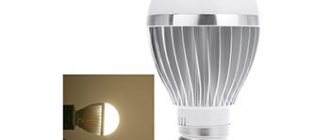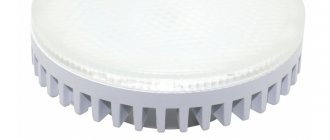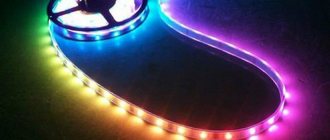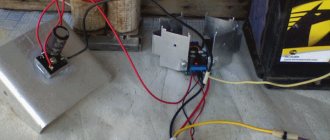Until recently, choosing an electric light bulb was a simple and straightforward matter. It was enough to tell the seller the desired power, and you received a device that shone brightly and consumed a lot of energy, or shone worse, but was a little more economical.
Now, in order to choose the right dimmable LED lamps, you need to have at least a minimum of knowledge - there are a lot of characteristics that affect their operation. In this article we will deal with the main ones so that you can understand more clearly the technical parameters indicated on the packaging and their meaning. This will allow you to choose the appropriate light bulb option.
What are dimmable lamps and luminaires?
Lamps, regardless of their operating principle, have a certain power, on which the intensity of the luminous flux depends. To increase or decrease the illumination, users have to replace the light bulbs or turn on a certain number of them, if this is provided for by the electrical wiring.
Dimmable lamps allow you to change the luminous flux at any time at your discretion using a dimmer - a direct or alternating current device, which is also called a dimmer or dimmer.
Manufacturers also offer LED lamps - this is a separate group of lighting devices that do not need additional regulators, since the dimmer “filling” is built inside them. The lighting intensity is changed using the remote control or buttons located on the body.
Main conclusions
A brightness controller for an LED strip is a practical and useful device that expands the lighting capabilities. It is universal, suitable for all tapes with the same parameters. Connecting the device does not pose any significant difficulties:
- connection to a power source (for multi-color ribbons - to the controller output);
- connecting the dimmer output to the corresponding contacts of the LED strip;
- checking polarity and correct connections;
- test connection of the backlight.
All detected deficiencies must be immediately eliminated, after which the regulator can be considered put into operation. Write your options for using a dimmer for LED strip or comments in the comments.
How to connect a dimmer
With all changes in operating features, the output electric current has a stable level equal to the specified value. Pulse devices are considered the best option for computer or digital control of a lighting system.
Expert opinion
It-Technology, Electrical power and electronics specialist
Ask questions to the “Specialist for modernization of energy generation systems”
Dimmer for 12 volt LED strip - how to connect the regulator The process of operation of a mini dimmer is to change the duration of the operating fraction of the period of rectangular pulse current transmitted to the equipment. Ask, I'm in touch!
Types of dimmers
Dimmers are electronic devices that differ not only in design, but also in their operating principle, design and other features. Before buying a dimmer, familiarize yourself with their structure and capabilities.
By installation method
Dimmers differ from each other in the way they are installed. When choosing the type of device, take into account the wiring and interior features.
There are three types of dimmers:
- For outdoor installation. These are overhead devices similar to regular light switches. Inside the device there is a dimmer for LED lamps. Plus - ease of installation. There is no need to drill a hole in the wall; the device is mounted directly on it. External dimmers are convenient in rooms where the interior is not a priority. They are also in demand in rooms with external wiring.
- For indoor installation. You have to make recesses in the walls for them, but they look beautiful in the most presentable interiors.
- For DIN rail. The device itself is placed in the electrical panel, and the power is controlled using a remote control.
By control method
The illumination is changed using different control systems. They all cope well with the task, and the choice of one type of dimmer or another depends mainly on preference.
Brightness controls are:
- Rotary. The simplest mechanical switch. The illumination level is changed by turning the knob clockwise or counterclockwise.
- Rotary and push. In appearance, they are the same as rotary ones, but their design allows you to press the light to turn on the brightness that was set the last time you turned it on.
- Push-button. These models look more modern and fit organically into interiors. The illumination changes after pressing the key.
- Sensory. Available in different designs. The sensors look like circles or rectangular panels.
According to the operating principle
There are dimmers that operate on AC and DC current. The first ones differ in the principle of voltage change.
There are two types of AC dimmers:
- Leading edge cutoff. This is the simplest and cheapest option. For use with dimmable lamps only. The use of dimmers with leading edge cutoff causes interference in electrical networks - this affects the operation of the TV and other sensitive devices. Scheme of work:
- the end of a half-wave is applied to the load, cutting off its beginning;
- a voltage of a given amplitude is supplied to the lamp, which decreases after the sinusoid passes through the zero mark.
- Trailing edge cutoff. Can work with non-dimmable lamps. The adjustment is better - without interference with electrical appliances, but there is one drawback - the illumination of the lamps does not change from zero, but in a certain light range.
Benefits of using devices
LED dimmable lamps help create a comfortable level of lighting in the room.
Advantages of dimmable lamps:
- Ability to create the desired lighting level by turning a knob or pressing a button. The adjustment is carried out smoothly, not stepwise.
- When the brightness of the light changes, the color temperature remains stable.
- There is a possibility of remote control. However, many models are equipped with buttons or rotary handles.
When using dimming LED lamps, it becomes possible to activate additional operating modes - simulating presence, blinking, dimming. There is an automatic shutdown function. It is implemented by setting a timer or other electronic control programs.
Advantages and disadvantages
It’s hard not to be interested in dimmable lamps – the ability to change the lighting intensity looks very tempting. Before you buy such lamps or fixtures, evaluate their advantages and disadvantages.
Pros of a dimmable lamp:
- Selecting the operating mode allows you to use the lamp for both intense lighting and light illumination in the evening.
- Dimmable LED lamps last longer than non-dimmable ones. If the latter are connected to a dimmer, they will quickly burn out due to exposure to extreme loads that their stabilizers cannot withstand.
- It can change the temperature of light transmission, which allows you to change the perception of space.
- Does not emit infrared and ultraviolet rays. Thanks to this, objects, fabrics, furniture upholstery, wallpaper and other things that are exposed to lighting do not burn out.
- Can be used for room zoning. To do this, individual lamps are connected to a dimmer and, by changing the brightness of the lighting, illuminate the desired areas of the room.
Dimmer lamps have much fewer disadvantages
- The main disadvantage is the high cost. Moreover, both the lamp itself and the control switch are expensive.
- There may be difficulties with choosing lamps and dimmers - they must match each other and be compatible. Some manufacturers produce lamps that are compatible only with dimmers of their own production.
- They can interfere with electrical appliances, sometimes flickering, humming and crackling (if the lamps are of low quality).
How does a dimmable LED lamp work?
Using dimmable lamps is easy. The user only needs to turn a switch or press a button to change the illumination. The processes taking place in the lamp and dimmer are much more complex.
How scientists “forced” an LED lamp to change the light intensity:
- Response of a non-dimmable lamp to adjustment. When trying to adjust the brightness of a regular lamp, at first nothing changes - the lighting device does not react in any way to turning the dimmer knob. This is explained by the driver program. It has a clear task - to maintain current and voltage values at a given level. If the input voltage becomes too low, the device finally reacts - it simply turns off the diodes (if the lamp is from a good manufacturer) or starts blinking (low-cost products). She “doesn’t understand” how to act.
- Operating principle of a dimmable lamp . The inventors solved this problem by changing the driver circuit. In a dimmable lamp, it monitors the voltage level that is supplied to its input. As soon as it changes, the driver automatically changes the current passing through the LED.
The dimmer changes the consumer's power by adjusting the voltage supplied to the load. The power decreases/increases along with the drop/increase in voltage. This dependence is expressed by the physical formula: P = I * U.
Current (I) and voltage (U) are related by Ohm's law: I = U/R. By increasing the load resistance (R), we reduce the voltage and power of the lamp.
The load resistance is adjusted using:
- resistors;
- capacitors;
- chokes.
The dimmable lamp itself is nothing special. Only in conjunction with the regulator does it acquire new functions. Dimmers operate on semiconductor devices that change resistance.
The operating principle of a dimmer depends on its type. The following dimmers are available:
- Resistive. The operating parameter is formed by changing the resistance of a rheostat or a variable resistor connected in series with the load. Maximum resistance corresponds to minimum current and minimum brightness. The disadvantage of such regulators is the constant power consumption. Because of this, it is not possible to save on electricity with it.
- Triac. Their work is based on the operation of a triac - a semiconductor element that changes the current curve to the required parameters. This is the best option for light regulation, as it allows you to save on lighting by reducing the intensity of the light flux.
Triac dimmers, unlike resistive ones, regulate not only brightness, but also color temperature.
LED strip installation diagram
- controlled power supplies. Capable of changing the voltage and current parameters at the tape input in a small range, which allows you to smoothly adjust the light intensity. The disadvantage of this type is the noticeable heating of the LEDs, which negatively affects the durability of the backlight and accelerates the degradation of the elements;
- pulse regulators of the glow mode. These devices use pulse width modulation (PWM), completely eliminating the shortcomings of previous designs. They do not change the parameters of the power source, but supply voltage intermittently. The shorter the pause between peaks, the brighter the LEDs burn, and vice versa.
Useful tips Connection diagrams Principles of operation of devices Main concepts Meters from Energomer Precautions Incandescent lamps Video instructions for the master Testing with a multimeter
Operation of dimmable LED lamps
To ensure that dimmable lamps serve properly and for a long time, use them correctly. If you choose and connect the LED light bulb correctly, there will be no problems with its operation.
Connection diagram
The way in which adjustable LED devices are connected to a circuit with a dimmer depends on the voltage they are designed for.
Inclusion options:
- Lamps for 220 V. The dimmer is installed in the open circuit of the load (lamp).
- Lamps for 12 and 24 V. In this case, a power supply is placed between the low-current dimmer and the network.
The dimmer itself has dimensions and mountings identical to a standard light switch, and is installed in the same way - placed in a mounting recess or mounted on the wall, depending on the design.
To realize the idea of adjusting the brightness of lighting, it is enough to replace a regular switch with a dimmer. This is not difficult to do. Both devices have 2 terminals that connect to the same wires to which the switch was connected.
When connecting a dimmer, polarity is not important. But if you have a phase indicator screwdriver and it is possible to determine the phase, it is recommended to connect the phase wire to terminal L (as required by the manufacturer).
Brightness adjustment
Dimmable lamps have a special driver that performs pulse width modulation. This device changes brightness from 5 to 100%. The illumination intensity is adjusted by changing the length and frequency of the pulse. The third parameter – amplitude – remains unchanged.
The brightness is switched mechanically or by touch - it depends on the type of dimmer. In any case, comfortable and smooth adjustment of the lighting level is ensured.
Life time
The service life of dimmable LED lamps is influenced, first of all, by the manufacturer. On average, they can burn from 15 to 40 thousand hours.
Factors influencing service life:
- Indoor microclimate. Lamps last the longest at moderate temperatures and humidity.
- Base. Models that have ventilation holes in the base have a longer service life.
- Circuit. The service life is reduced due to voltage surges and poor-quality wiring.
- Connection. Lamps last longer if they and the dimmer are properly connected to the network.
- Quality. Low quality products last less. Service life can also radically reduce manufacturing defects.
Advantages of dimmable light switches
The main advantages of using this electronic device are as follows:
- Reducing the brightness of LED lamps by adjusting;
- Increase energy savings by selecting the required power;
- Creating comfort and atmosphere suitable for every moment of life, without having to perform time-consuming replacement of lamps;
- Less pollution and more respect for the environment;
- Savings on bills: energy efficiency class A+ or higher;
- Increased service life of LED light sources due to lower operating temperatures.
To enjoy all these benefits, all you need to do is buy a dimmable e27 LED bulb.
However, it should be remembered that if you want to connect a dimmable LED lamp to the same dimmer along with a compact or high-induction fluorescent lamp, it will cause an annoying effect called "flicker" or annoying noise, so it would be better to replace the fluorescent lamps with the same stepped ones (E27, E14, R7S, G9, Gu10, Gu 5.3).
It is recommended to use the same type and, if possible, brand of lighting connected to the dimmer circuit to avoid failure.
Why can't regular lamps be used with a dimmer?
Ordinary lamps cannot be connected in the same circuit with a dimmer. It's all about the design. A simple LED lamp has a micro-rectifier that converts the input AC voltage to DC. A regular LED light bulb can only be in two positions - on or off.
A dimmer assumes a completely different approach to lamp operation. With its help, a smooth and gradual change in the level of illumination is carried out. If you screw an ordinary, non-dimmable lamp into a circuit with a dimmer, it first blinks and then turns on 100%.
If the lamp burns at full power in the same circuit with the dimmer, both devices become unusable after a short time. Inside dimmable light bulbs there is a special unit through which the brightness is adjusted.
How to choose the right quality dimmable lamp?
The dimmable lamp has the same design as its conventional counterparts. It consists of a diffuser, a radiator and a base. They screw into standard cartridges.
Lamp characteristics
Stores sell dimmable lamps that differ from each other in a variety of parameters. When buying LED lamps, you cannot focus only on appearance, manufacturer or price. Today there are a lot of models of LED light bulbs on the market, and not every consumer will immediately understand them.
Characteristics:
- Operating voltage. Its fluctuations in the network can exceed the critical 230 V. In order for the lamp to work stably, it is desirable that it be designed for the widest possible range - 170-260 V.
- Supply voltage. There are products on sale for 220, 12 and 24 V. Lamps with a voltage of 12/24 V are intended for lamps that have voltage converters.
- Colorful temperature. The color of the light flux depends on this parameter - it can be yellow or white. The first one is considered warm, the second one is considered cold. At a color temperature of 4-5 thousand Kelvin the light is white, at 2.7-3 Kelvin it is yellow.
- Light flow. It is measured in Lumens and determines the brightness of the lamp. The indicator varies between 200-2,500 Lumens.
- Color rendering index RA. Determines the uniformity of the color elements of the light flux. With low RA values, it is difficult to distinguish shades of colors. The higher it is, the less strain on the eyes.
- Power. Manufacturers produce products from 1 to 25 W. The higher the power, the more intense the lighting.
- Base. Today you can buy a dimmable lamp with all types of bases found in conventional analogues. Types of bases: E27 – standard base, which is used in chandeliers and lamps installed in residential premises;
- E14 – used in floor lamps, chandeliers, sconces, lamps;
- GX53 - for lamps and luminaires installed in rooms with high humidity levels;
- G9 – for luminaires used in spot lighting;
- GU10 - for decorative lighting.
When buying light bulbs, pay attention to their shape and dimensions. They must fit not only the base, but also the size of the shades, chandeliers and lamps.
Differences between a dimmable light bulb and a regular light bulb
In appearance, dimmer lamps are the same as conventional LED light bulbs. If you put two LED lamps next to each other - dimmable and non-dimmable - it is impossible to distinguish them.
Miniature devices that change the luminous flux are located inside the lamp. The dimmable device is recognized only by its markings. The packaging must bear one of the following inscriptions/icons:
- "dimmable";
- "dimmable";
- image of a rotary dimmer knob.
If the lamp says “not dimmable”, it is not suitable for adjustable lighting.
Risks when purchasing
If the buyer does not have experience using dimmable LED lamps, do not rush into the purchase. The main risk when purchasing is purchasing a model that is incompatible with the already installed dimmer. Many buyers do not have the opportunity to understand in advance whether a lamp is suitable for a dimmer or not.
Tips for those who are going to buy an LED lamp:
- Agree with the seller about the possibility of returning the product if its parameters turn out to be unsuitable.
- Take light bulbs from well-known manufacturers - this increases the chances that they will match the characteristics of the dimmer.
- Do not take low-power lamps up to 10 W. They cost less, but provide low light output, a small range of adjustment and “cold” lighting, which is unpleasant for the eyes.
- Pay attention to the base so that it fits the cartridge. There are threaded and pin sockets. Check this point and find out what diameter of the base you need.
For those who do not know how to select a light bulb according to its parameters, it is recommended that you first read the technical documentation for the dimmer and lamp. The shopping center's consultants also help you make the right choice.
What are the problems at work?
Problems may arise when using dimmable LED lamps. To eliminate malfunctions, you need to know the reasons that caused them.
The lamp is not adjustable in the power range of 10-15%
The light flux emitted by the LED lamp can be reduced to 10% of the maximum. If you cannot change the brightness level in the range from 10 to 15% of power, then the cutter is of low quality. The second option is that the dimmer is not suitable.
The solution to the problem is to buy high quality products from well-known manufacturers and with a minimum threshold for switching on and off.
Flicker
If the circuit uses a switch that has an indicator light, the light bulb will begin to flicker when the light is turned off. The solution to the problem is to turn off (remove) the indicator or install a new switch.
Another possible reason for the flickering of a dimmable lamp is a driver failure. In this case, the light bulb needs to be replaced.
Buzzing
If the light bulb makes an unusual sound, it means that it and the dimmer are incompatible in various respects. Due to device mismatches, the lamp may not only hum, but also turn on/off from time to time. The solution to the problem is to replace the dimmer or LED lamps.
Another reason for the hum is a driver failure. In this case, you also cannot do without replacing the lamps.
Dimmer is not suitable for 220 V network
If the 220 V lamp is of high quality, any dimmer model for a standard network is suitable for it. If the dimmer is cheap and of low quality, it may not cope with the assigned tasks.
To avoid problems, a dimmer is purchased after consultation with a specialist or after testing it in operation.
The concept of a dimmer and its scope?
This concept is characterized by a special electronic device, with which you can regulate power, i.e. Brightness can be adjusted to suit your needs. This is convenient in a situation where lighting is needed in the room, but at the moment a small child is sleeping in it. Then, just you will need to adjust the brightness.
Many people believe that the product we are considering is not capable of working in conjunction with a dimmer. This judgment is wrong. They can function together, but the adjustment work may be unstable. Technically, these lamps are designed in such a way that they only provide switching on and off. They are not provided with additional options.
The best type for this is a dimmable LED type. They cost a little more than the classic version, but are much cheaper compared to a separate device of lower power. This will allow you to significantly save on room lighting.
You can adjust the light level in two ways:
- Using a dimmer that is installed on the wall;
- Using the phone.
Please note that they will vary in cost. The latter method will be more expensive, and its price will depend on the device model used.
The most popular manufacturers
When buying LED lamps, pay attention to the manufacturer. This allows you to purchase high-quality products with a long service life. There are several well-known brands on the domestic market offering high-quality lamps.
Osram
This German company is known throughout the world as a manufacturer of high-quality lamps, luminaires and other lighting equipment. It produces LED lamps in a wide range, with sockets of different types and sizes.
Lamps with E14 and E27 sockets are produced in the form of balls and candles; they are used in chandeliers, floor lamps, and lamps.
Pros:
- high color rendering coefficient - above 80;
- large selection of lamps;
- excellent performance characteristics, including inexpensive models;
- efficiency.
The disadvantages of Osram products include:
- high cost;
- possibility of marriage.
Philips
Dutch world famous company producing lighting equipment. The brand uses innovation and produces products with a long service life - up to 40 thousand hours.
Pros:
- maintaining brightness with a long service life;
- high energy efficiency;
- safe for vision due to specially set temperature parameters and lack of flicker;
- wide selection of lamps;
- There are models in which the color temperature is adjustable.
Minuses:
- high price;
- small dispersion angle for inexpensive models.
Gauss
Domestic Gauss lamps are distinguished by a wide input voltage range (185-265 V), which expands the possibilities of their use in areas with unstable power supplies and low-quality electricity supplies. Lamps with predominantly rich, bright white light.
Pros:
- high color rendering index – reaches 90;
- long service life - up to 50 thousand hours (if translated into everyday use, the lamps last about 35 years);
- warranty periods – 3-7 years;
- beautiful design, suitable for modern interiors in high-tech style and others;
- There are many models with switchable lighting temperature.
Gauss presents a series of lamps that implement the principle of step dimming. They do not need a dimmer - it is built into the lamp.
Minuses:
- are expensive;
- rarely sold in stores (must be ordered online);
- not compatible with many switches and dimmers - you have to check for compatibility before purchasing.
Uniel
Another domestic manufacturer whose Crystal and Palazzo series are especially popular. The lamps from this company are universal and work with almost all AC dimmers. They have a matte bulb and a standard base, like conventional incandescent lamps. They operate in the range of 175-250 V.
Uniel lamps are sold in all major stores. Previously, they were produced in China, and recently they opened a factory in Russia, which produces the most popular models - pear-shaped lamps with an E27 base. Service life – 30 thousand hours. All products have a three-year warranty.
Pros:
- high color rendering – up to 80;
- wide range of models;
- moderate cost;
- do not reduce brightness when the voltage drops to 133 V.
Minus - they do not work with switches equipped with indicators.
Dimmable lamps allow you not only to adjust the lighting to your needs, but also save energy. The main problem is the incompatibility of devices. To avoid this, carefully study the technical parameters of lamps and dimmers before purchasing.











